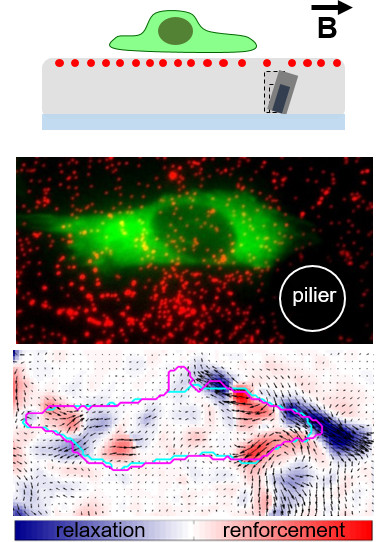
Magneto-active substrates for local mechanical stimulation of living cells
C.M. Bidan, M. Fratzl, A. Coullomb, P. Moreau, A.H. Lombard, I. Wang, M. Balland, T. Boudou, N.M. Dempsey, T. Devillers* and A. Dupont*
Scientific Reports 8, 1464 (2018) [Accès à la revue]
Les cellules sont-elles chatouilleuses ? Afin de tester de manière précise la réaction de cellules adhérentes à une stimulation mécanique, nous avons développé des substrats magnéto-actifs. Grâce à des micro-piliers en Fer inclus dans une couche de matériau élastique, nous sommes capables de tirer localement sur une partie de la cellule. Ce dispositif étant inclus dans un microscope, nous pouvons observer en direct l’évolution de différents marqueurs fluorescents lorsqu’une cellule vivante est stimulée de la sorte. Comme preuve de principe de ce nouveau système expérimental, nous montrons que les cellules sont chatouilleuses : juste après une stimulation mécanique, les cellules sont devenues plus agitées !
Abstract: Cells are able to sense and react to their physical environment by translating a mechanical cue into an intracellular biochemical signal that triggers biological and mechanical responses. This process, called mechanotransduction, controls essential cellular functions such as proliferation and migration. The cellular response to an external mechanical stimulation has been investigated with various static and dynamic systems, so far limited to global deformations or to local stimulation through discrete substrates. To apply local and dynamic mechanical constraints at the single cell scale through a continuous surface, we have developed and modelled magneto-active substrates made of magnetic micro-pillars embedded in an elastomer. Constrained and unconstrained substrates are analysed to map surface stress resulting from the magnetic actuation of the micro-pillars and the adherent cells. These substrates have a rigidity in the range of cell matrices, and the magnetic micro-pillars generate local forces in the range of cellular forces, both in traction and compression. As an application, we followed the protrusive activity of cells subjected to dynamic stimulations. Our magneto-active substrates thus represent a new tool to study mechanotransduction in single cells, and complement existing techniques by exerting a local and dynamic stimulation, traction and compression, through a continuous soft substrate.
Thème : Thème 2011-2014 : Mécanique, adhésion et motilité
Equipe : MOTIV (LSP)
